Changing the face of Classics in theatres and museums
Submitting Institution
University of GlasgowUnit of Assessment
ClassicsSummary Impact Type
CulturalResearch Subject Area(s)
Language, Communication and Culture: Literary Studies
History and Archaeology: Curatorial and Related Studies, Historical Studies
Summary of the impact
University of Glasgow researchers have utilised cutting-edge 3D imaging
techniques to enlarge
miniature 4th century Greek theatre masks into life sized objects,
transforming how these masks
are displayed as museums artefacts and used in performance. Full-size
reconstructions of the
masks are now on permanent display in the Kelvingrove Art Gallery and
Museum, Glasgow — seen
by more than 1 million visitors annually — and exhibitions featuring the
reconstructions have toured
across the UK and Ireland. These masks are also now incorporated into the
work of theatre groups
in the UK and Italy, highlighting the influence of a lost European masked
theatre practice on the
foundation of modern drama.
Underpinning research
Elizabeth Moignard (Lecturer in Greek 1978-96, Senior Lecturer in
Classics 1996-2000, Professor of
Classical Art and Archaeology 2000-2011, Emeritus Professor 2011 to
present) has researched
the use of masks in the 4th century plays of Menander (342BC-291BC), one
of the best-known
practitioners of the Greek `New Comedy', an influential foundation for
modern drama, with its
emphasis on human relationships rather than public affairs. With £277,000
in funding from the Arts
and Humanities Research Board (AHRB), she was the principal investigator
on the four-year Masks
for Menander project (2001-2005), with Richard Williams RA
(subsequently at University of
Durham). The aim of the project was to research ancient Greek theatre
masks — particularly those
defined by association with stock characters used by Menander and versions
of these appearing
as ancient votive terracottas (or sacred offerings) in the Kelvingrove and
other museum collections.
Combining experimental archaeology and practice-based research, Moignard
and Williams
investigated the performance qualities and style of the masks of Greek
`New Comedy'. They used
3D imaging to scan around fifty New Comedy artefacts from UK and European
museums, and
conducted studio research with full-size reconstructions of the masks,
scaled exactly from the
three-dimensional coordinates.
Employing leading-edge 3D scanning technologies provided by the
University of Strathclyde's
Rapid Design and Manufacture Centre, the project broke new ground in
ancient theatre research.
This was achieved by reverse-engineering and rapid prototyping of the
artefacts, and by the
objectivity of the mask construction and studio research. The researchers
found the best of the
miniatures conserved both the proportions of full-size originals and the
`aspects' — balance, flow of
lines, asymmetries and other qualities of a performable mask. The
artefacts therefore provided
more significant evidence for ancient performance than had ever been
previously recognised.
References to the research
— AHRB grant (£277,000) for Masks for Menander 2001-2005 (PI E.
Moignard; RA R. Williams)
(link).
Details of the impact
By reconstructing full-sized versions of miniature terracotta masks from
museum collections
around the world, the Masks for Menander project gained significant
insight on the tradition and
practice of an ancient performance style. This insight simultaneously
enabled theatre to recover
the acting style and cultural significance of a lost European mask theatre
tradition, and museums
to develop access and information to a wider public audience. Therefore,
the unique outcome of
this project is how Masks for Menander linked curatorial and
performance traditions, redefining the relationship between two
distinctive cultural practices.
 Figure 1: Reconstruction of
Greek comic mask,
Kelvingrove Art Gallery and
Museum
Figure 1: Reconstruction of
Greek comic mask,
Kelvingrove Art Gallery and
Museum
Rediscovering lost, ancient theatre traditions
The Masks for Menander project, led by Moignard, shed light on the
traditions and practices of an era in theatre that heavily influenced
subsequent Roman playwrights Terence and Plautus and is considered
the source of a European comic tradition. Elements of Greek `New
Comedy' remain visible in modern drama, particularly the focus on
relationships and personalities, which was a departure from the Old
Comedy emphasis on politics and public affairs. Working in collaboration
with the Scottish Mask and Puppet Centre and Italian theatre company
VeneziaINscena, University of Glasgow researchers Moignard and Williams
sought to recover the
acting style and cultural significance of New Comedy. They highlighted the
influence of this lost
European mask theatre tradition by research in the studio with experienced
mask professionals,
training of drama students, public performances and other events.
Mask theatre is a unique combination of body movement and the visual
stimuli of the masks, which
are sculpted to appear to change with the facial expressions or movements
of the actor wearing
them. Scaling the masks up from miniature artefacts to life-sized models
using rapid prototype
techniques allowed theatre professionals, together with the researchers,
to focus on and work with
the theatrical properties of the masks.
While the initial performances fall outside the eligible timeframe for
impact, they were an important
element of practice-based research and served to enhance the researchers'
and practitioners'
awareness of the proficiency of acting in antiquity, paving the way for
subsequent impact. Since
2008, the exploration and demonstration of masks in ancient and
contemporary theatre, including
in collaborative projects with mask theatre professionals, has continued.
VeneziaINscena
established the International Centre for the Study and Use of Masks
(Centro Internazionale della
Maschera) in 2005 (after collaborating with the Masks for Menander
project). Since then, they have
continued to incorporate the mask reproductions in their work, offering
workshops in Greek drama
to train actors in the use of masks in the theatre, which draw on the
research findings of the
project. The Centre collaborated with the Accademia Teatrale Veneta to
hold an intensive month-long
workshop in July 2008 on the Greek masks.
The Director of the Scottish Mask and Puppet Centre describes the impact
of this collaboration:
For the first time since the 4th century AD, the project has uncovered the
relationship
between the terracotta miniatures and the actual theatre masks. The
reconstruction process
using 3D imaging and scanning has enabled life-sized reconstructions to be
made with sub-millimetre
accuracy of the originals. The small helmeted miniatures were the key to
unlocking
the lost theatre masks of Menander. The New Comedy Masks of Menander
Project under the
direction of Professor Moignard brought together art historian, Dr Richard
Williams, mask-maker
Malcolm Knight [Scottish Mask and Puppet Centre] and theatre director
Adriano
Iurissevich [VeneziaINscena] in a unique collaboration. The repercussions
of this
collaboration are still ongoing in the lives of all whom took part.
In 2013, the mask reproductions were included in the BBC 2 programme Who Were
The Greeks?
(first broadcast 27 June 2013) and the original shells and moulds now
adorn the external facade of
the Scottish Mask and Puppet Centre in Glasgow, recast in stone.
Improving study and management of objects in museum collections &
exhibitions
A tangible legacy of the Masks for Menander project lies in the evolution
of the work at the
University of Glasgow on the masks themselves as antiquities. This work is
providing insight into
ancient theatre to a wider public audience. More than 2,000 mask artefacts
survive in collections
across Europe. Using rapid prototyping technology, Moignard and Williams
3D-scanned around
fifty of the ancient masks preserved in the Kelvingrove, Ashmolean and
Fitzwilliam Museums, the
Shefton Museum, Newcastle, and the Museo Aeoliano Lipari,
Italy. Using 3D printing, they then successfully created both
artefact-size replicas and enlarged matrices for life-size
wearable masks which reproduced the original forms without
the mediation of a modern sculptor. The project made a
significant contribution to the major `Expressions' display in the
Kelvingrove Art Gallery and Museum on its reopening in 2006
after a three-year refurbishment closure. The exhibit — a
permanent display to date — uses both a selection of the
original terracottas and the masks derived from them.
Moignard and Williams worked closely with the museum
curators to help develop informative and current labelling for the display
which refers to the findings
of the Masks project. As part of the Expressions display, which is centrally
located in Kelvingrove
(2nd most visited
UK museum outside of London in 2012), the exhibit is seen by more than
1.03
million visitors each year.
 Figure 2: 'Expressions', Kelvingrove
Art Gallery and Museum
Figure 2: 'Expressions', Kelvingrove
Art Gallery and Museum
Between October 2007 and February 2008, some of the mask reproductions
were featured in In
Scaena (On Stage), an exhibition
at the Coliseum in Rome, with the exhibition catalogue
containing photographs of three masks. In the UK, Behind the Mask,
an exhibition using the Masks
for Menander alongside masks from other cultures, curated by Williams in
collaboration with
Malcolm Knight of the Scottish Mask and Puppet Centre, toured The Ark
(Dublin, 2008), Tunbridge
Wells Museum (2009), Hackney Museum (2010), Summerlee Museum (Glasgow,
2010) and
Cannon Hall (Barnsley, 2011). 3D-printed replicas were displayed together
with full-size masks
and a video installation of performance.
Sources to corroborate the impact
Contribution to the rediscovery and incorporation of ancient mask theatre
traditions in UK and Italy:
— Contact details and statement from the Director of the Scottish Mask
and Puppet Centre —
available from HEI
— Contact details for Director of VeneziaINscena, Italy, available from
HEI
— Information leaflet for VeneziaINscena workshop in July 2008 —
available from HEI
— BBC Two — Who Were the Greeks? (link)
Contribution to management and exhibition of artefacts in museums
— In Scaena Exhibition Catalogue — link
and available from HEI